To mark 500 subscribers, I’m revisiting and updating an essay from November 5, 2022 when Rock & Hawk had fewer than 90.
A Sharp-shinned Hawk, Accipiter striatus, looked for breakfast by the feeders. The hawk’s prey of choice is birds. It perched in waiting for any unsuspecting soon-to-be-meals. I’d just filled the feeders so would’ve felt some accountability if it killed anything. That feeling would’ve been misplaced. Wendell Berry wrote that a person must get back to the woods to see the world’s “ability to thrive without him.” With or without me filling the feeders, the Sharp-shinned Hawk would’ve gotten its meal.
I wasn’t in the woods, but the hawk is of the woods—particularly accipiters, “colloquially called forest hawks because they prefer to nest and hunt in forest habitats” says HawkWatch International. “Their bodies are made to thrive in this environment, having short wings and a long rudder-like tail that helps them maneuver through the dense canopy.”
You likely know Buteos, a genus of “large, broad-winged, short-tailed lugs with spare and labored wing beats”—or at least know a buteo, the Red-tailed Hawk. There are also Accipiters, a genus of smaller hawks that fly “with short, rapid, bursting flaps, punctuated by a glide.”
Sharp-shinned aren’t ridiculously hard hawks to come by. The hard part is differentiating them from Cooper’s, Accipiter cooperii. Years ago I mistook an accipiter in flight for a Cooper’s instead of a Sharp-shinned, so made a point of learning the differences.
I was reassured by Audubon. “When identifying Cooper’s and Sharp-shinned Hawks, it’s okay to not have a definitive answer. These two species look almost exactly alike and have very similar habits. Lots of birders—expert birders—have come away shaking their heads and jotting down ‘Cooper’s/Sharp-shinned’ in their notebooks.” Jerry Liguori adds, in Hawks From Every Angle, “at most hawkwatching sites throughout North America…‘unidentified accipiters’ make up the majority of unidentified raptors.”
Sharp-shinned Hawk is the tiniest accipiter in North America—a genus with Cooper’s Hawk, Accipiter cooperii, and Northern Goshawk, Accipiter gentilis. Sharp-shinned have diminutive heads, their wings are short and rounded. “In terms of overall Gestalt,” Hawks in Flight explains, “Sharp-shinneds are stocky accipiters; Cooper’s Hawks appear lanky.”
Head size and shape matters. Audubon describes the head on a perched Cooper’s as “sort of like a block stacked on top of its body.” More square than a Sharp-shinned’s. In flight, a Sharp-shinned Hawk’s head extends just beyond its wings, and the wings might seem pushed forward. To look to the side as it flies, a Sharp-shinned has to lower a side of its body. A Cooper’s doesn’t, its head sticks out far enough.
Thoreau described Sharp-shinned Hawks as “with a long tail and distinct from wings.” The tail is indeed long. Along with head size/shape it’s important to pay attention to the tail. The Sharp-shinned’s is squared off with a white tip. It can look as if the hawk dipped its tail in white paint. It can also be notched. A Cooper’s is rounded, also with a white tip but it’s wide, a terminal band. Don’t let tails be the only thing you use to tell accipiters apart: tail and head together. Either by itself doesn’t typically cut it. “Accipiter tails show a fair degree of variability,” Hawks in Flight explains, and “tail shape is affected by molt and feather wear.”
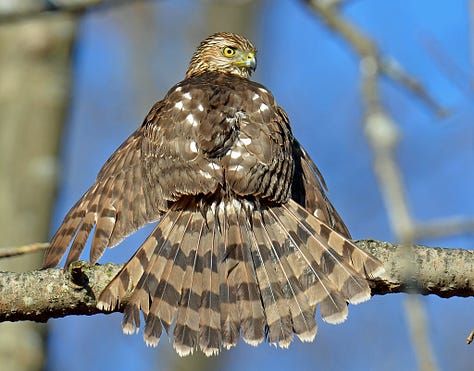
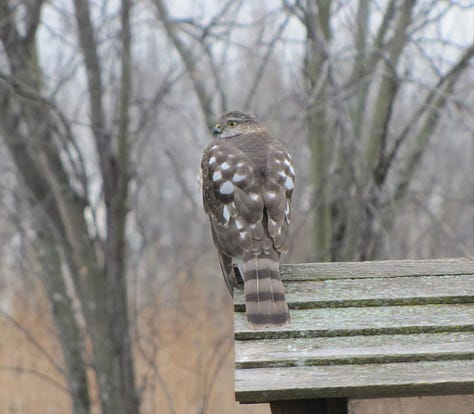

My old Audubon guide calls Sharp-shinned “jay-sized” and Cooper’s “crow-sized.” Sharp-shinned are easy to miss, so keep an eye out in your neighborhood.
These small accipiters are made for forests, but do well in suburbia. iNaturalist says they frequent “rural, suburban and agricultural areas, where they often hunt at bird feeders.” Once, a non-birder watching my feeders witnessed a Sharp-shinned get a meal. I was excited, but was alone in that reaction.
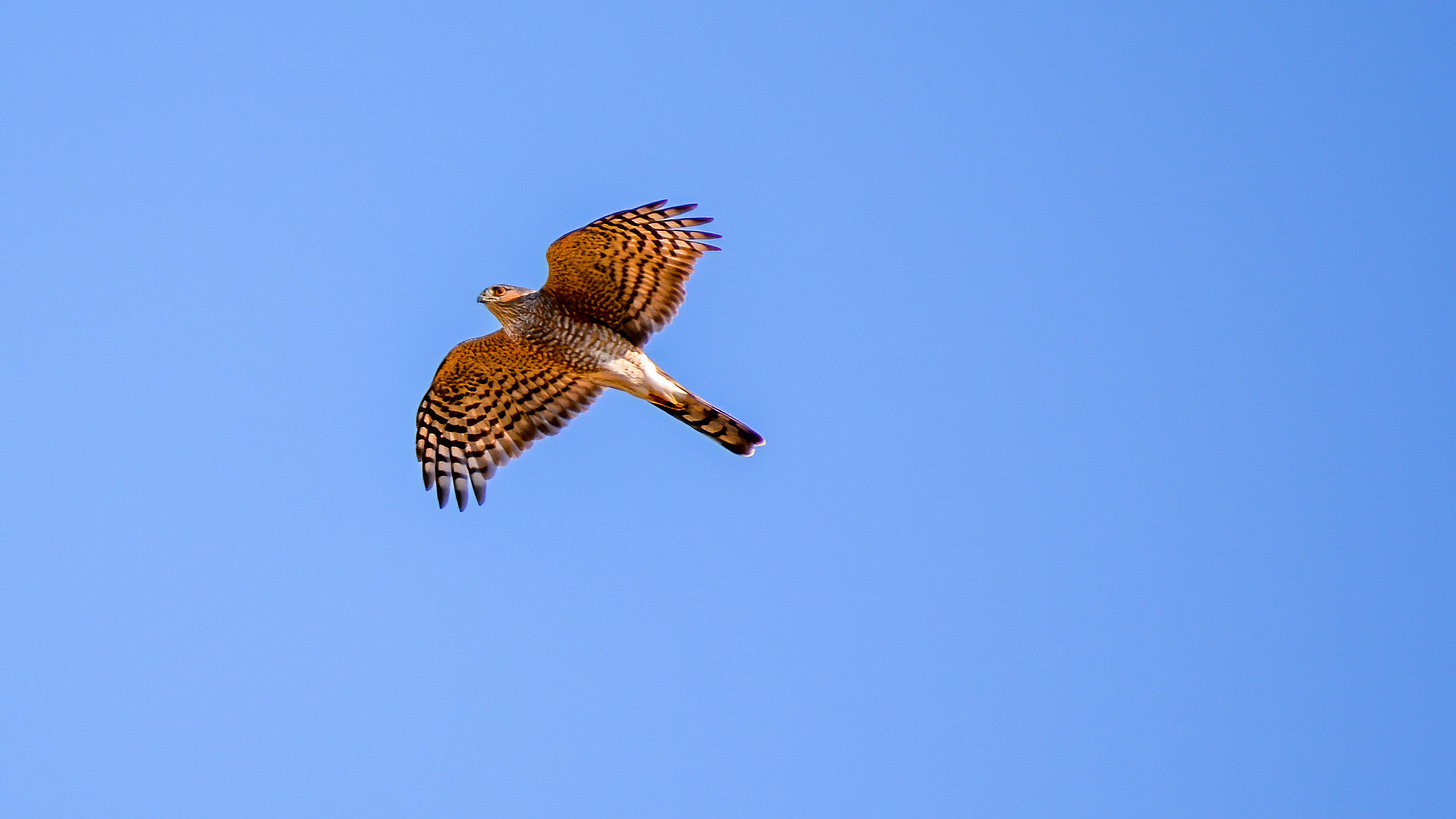
Northern Goshawks are much bigger. This size difference is critical, in other ways a Goshawk can appear very similar to a Sharp-shinned. Hawks in Flight’s “Telling Accipters Apart” section begins plainly: “When an accipiter is spotted through the binoculars, the first thing to determine is its size.” My Audubon guide, which calls Cooper’s and Sharp-shinned Hawks “crow-” and “jay-sized,” plainly calls the Goshawk “robust.” Goshawks have a white eyebrow. A mature Goshawk has barring on the stomach and breast.

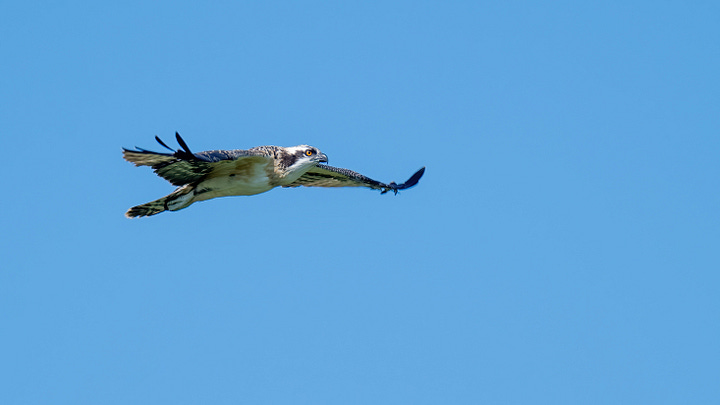
Juvenile Goshawks have brown streaking and look more like other accipiters. Streaking goes longitudinally, barring goes latitudinally (e.g. a Peregrine’s belly, Falco peregrinus).1
The Northern Goshawk is found in the woods. Hawks in Flight calls it “a large, reticent raptor of northern forests.” The bird prefers its forests coniferous and shows “a legendary single-mindedness with regard to prey.” Grouse.
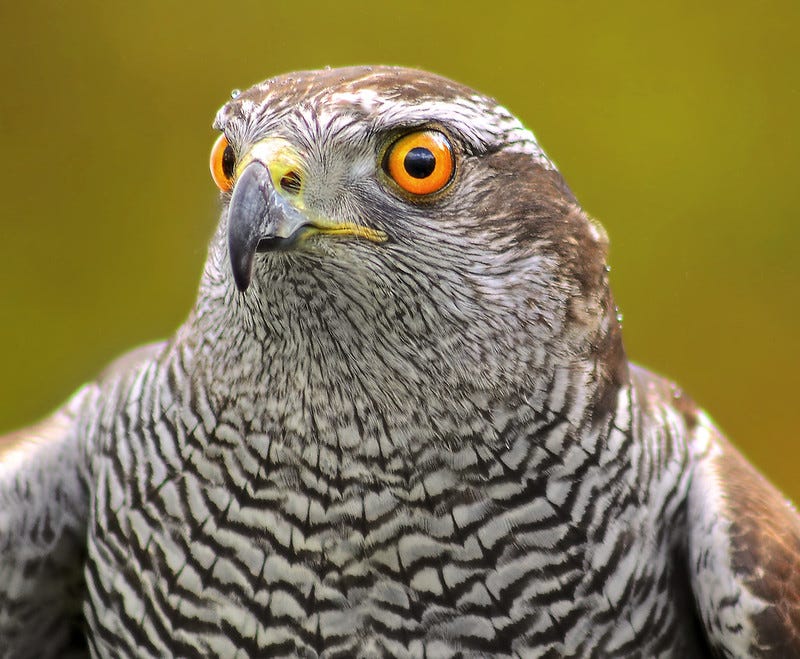
They were known as Goose Hawk—Goshawk comes from the Old English. Falconers used them to go for geese. The raptor, pointed out in this episode of Wild America, “could be more appropriately called ‘Grouse Hawk,’ because no other predator pursues the hard-to-catch Ruffed Grouse with such supreme skill.” Chances are if you see an adult Goshawk you won’t confuse it for a Cooper’s or a Sharp-shinned. It’s still not out of the question. Accipiters show reversed sexual size dimorphism. Females are bigger. Large Cooper’s Hawks, females, aren’t that far off in size from smaller Goshawks, males.
Size should be the first thing you note when identifying an accipiter, but that isn’t to say it makes things any easier. A female Sharp-shinned, the larger of the sexes, and a male Cooper’s, the smaller, can be close in size. To boot, Hawks From Every Angle explains “the undersides of Sharp-shinned and Cooper’s Hawks are almost identical.” Similar plumage and similar size, leaving flight style.
I have seen a Sharp-shinned Hawk’s wingbeats described as snappy. Despite this, of the accipiters they tend to move slowest. There’s not a ton of oomph behind the wingbeats, a Goshawk’s have oomph. Cooper’s and Sharp-shinned Hawks do have similar flight styles, though the Cooper’s, being a larger bird, does have slower wingbeats. “The bird flaps as though it were arthritic,” to quote Hawks in Flight again. To buttress that, Liguori: “The wing beats of Cooper’s Hawks appear as shallow as those of Sharp-shinned Hawks but are stiffer and more forceful.” They appear more “deliberate in flight compared with the anxious manner of Sharp-shinned Hawks.” Thoreau described the Sharp-shinned’s flight as “not circling nor tacking, but flapping briskly at intervals and then gliding straight ahead with rapidity, controlling itself with its tail.” There’s no way to avoid the fact they’re tough to tell apart. Learning your accipiters is a rite of passage—more difficult than learning Downy from Hairy Woodpeckers.
Since accipiters eat birds, they are not always popular among people with feeders. Sources online might instruct you to remove hawk perches near your feeders, or keep your feeders near safety for songbirds to abscond to. That article makes the important statement: “by deciding to feed birds, it’s almost inevitable that hawks will be hanging around with the increased activity.” It’s still a version of deciding to feed birds.
Hawks are beautiful and humbling. The fact hawks eat birds at feeders is a reality, not something to be happy or unhappy about. It’s in the avian realm, which we are not part of. I’ve written of the natural world’s fierce indifference, good to be reminded of.
The Sharp-shinned Hawk is a strong reminder, maybe more than the redtail. The redtail is a burly buteo, it looks its part. A Sharp-shinned is a slight accipiter, “jay-sized.” Its killer instinct is not so obvious. Redtails are common. It’s also not uncommon to see a Sharp-shinned hunt at a feeder. If you have one, you don’t necessarily have to leave the house to see wild ferocity. To us, birds at a feeder are nice to watch. To an accipiter, they’re lunch.
Jeffers urged us to practice Inhumanism, “a shifting of emphasis and significance from man to not-man.” A Sharp-shinned or Cooper’s Hawk might facilitate that shift. Something you come across fairly often in nature writing is that we’ve become “detached,” or “out of touch.” We have. Jeffers says of “the wild God of the world”:
You do not know him, you communal people, or you have forgotten him; Intemperate and savage, the hawk remembers him; Beautiful and wild, the hawks, and men that are dying, remember him.
That wild God is harder to forget when a hawk is intemperate and savage around your bird feeder. The hawk remembers him and can remind us. In “The Purse-Seine,” Jeffers writes of humanity being doomed because we’ve lost closeness with nature. Looking over a city, he is reminded of sardines caught in a seine-net:
There is no escape. We have gathered vast populations incapable of free survival, insulated From the strong earth, each person in himself helpless, on all dependent. . .
What better way to appreciate “the strong earth,” than by concerning yourself with a Sharp-shinned Hawk? A Sharp-shinned Hawk plucking a chickadee from your feeder is a good reminder of the intemperate and savage. A feeder might provide an oasis for you, something to observe. It is not an oasis from indifferent, animal brutality.
Your feeder is both a stopping point for hungry songbirds and a hawk’s potential hunting grounds. To a Tufted Titmouse your feeder provides reliable food. It can provide the same for an accipiter.
Recommended Reading:
Hawks in Flight - Pete Dunne, David Sibley, and Clay Sutton (purchase at Buteo Books)
Thoreau's Notes on Birds of New England - Henry David Thoreau, edited by Francis H. Allen (purchase at Dover Publications)
Hawks From Every Angle - Jerry Liguori (purchase at Princeton University Press)
White-tailed Deer: Trail Guardians - Meditations on Nature | Korean-style Sijo Poems,
“An Autumn morning over a field of of muted colour. / A pair of deer with tails of white, stand curious yet guarded.
The Written Word - Kent’s Substack,
“I guess the only conclusion I can come to is that for me the written word is my preferred medium of expression.”
When the Blue Jays Have Had It with You - Nature Moments,
“The thing about Blue Jays is, they are entirely too observant. Also absurdly clever. And way, way too suspicious. All in all, they are just not having it with my painstakingly slow efforts to approach the window with a camera and record them in all their cerulean glory.”
If you enjoy Rock & Hawk, consider subscribing. For small, one-time contributions I have a “Buy Me a Coffee” tip jar. Liking, sharing, and/or commenting cost $0.00.
Streaking and barring are pretty straightforward, streaks go up and down, bars go across, but plumage has plenty of terminology. Particularly raptor plumage. Here’s a helpful glossary from HawkWatch.


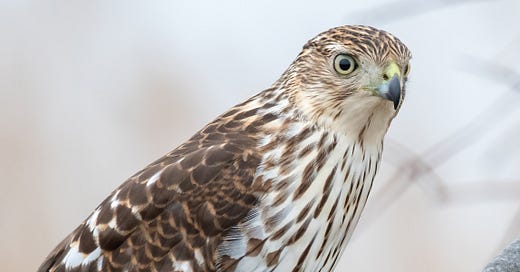


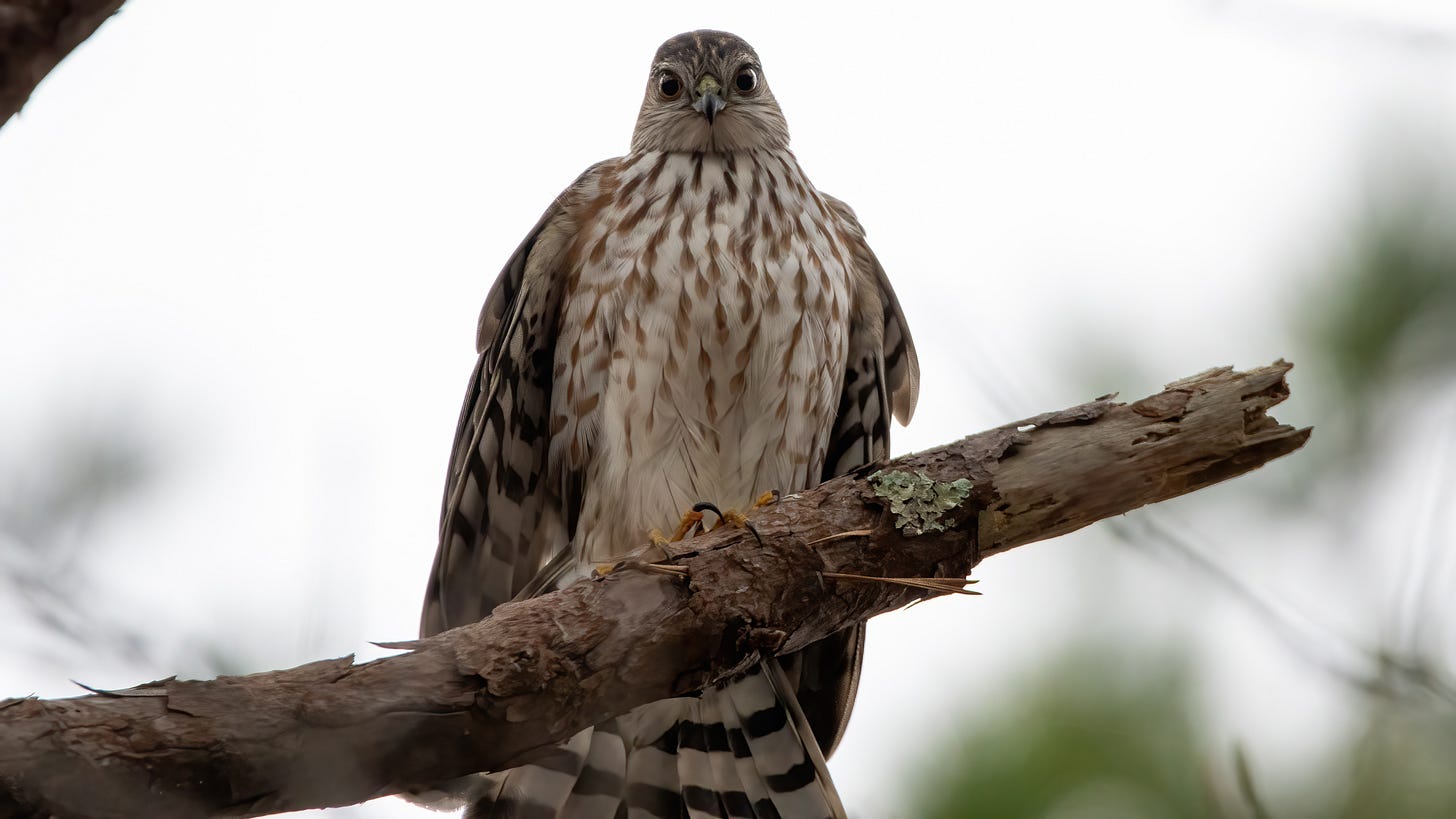

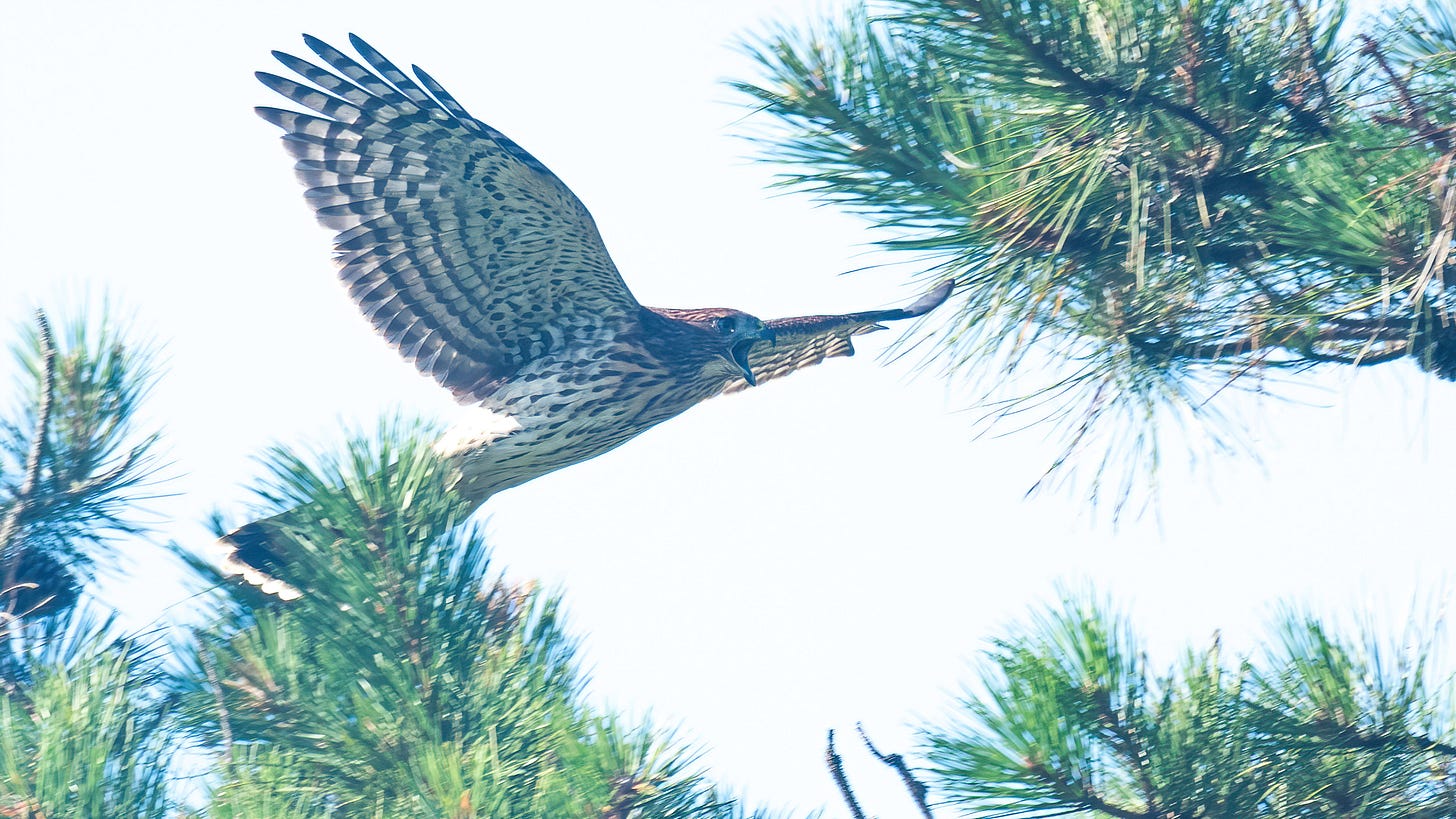
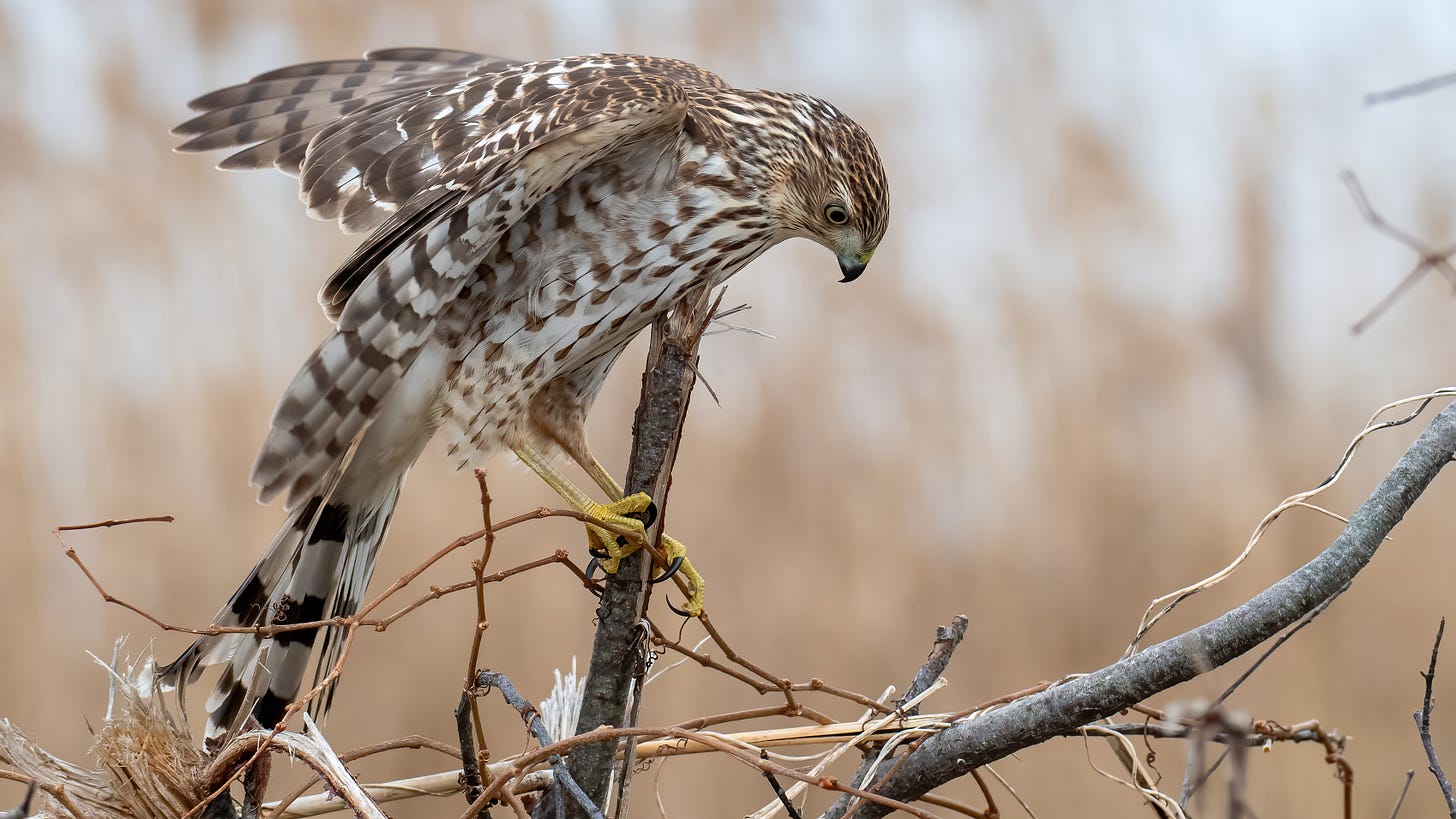
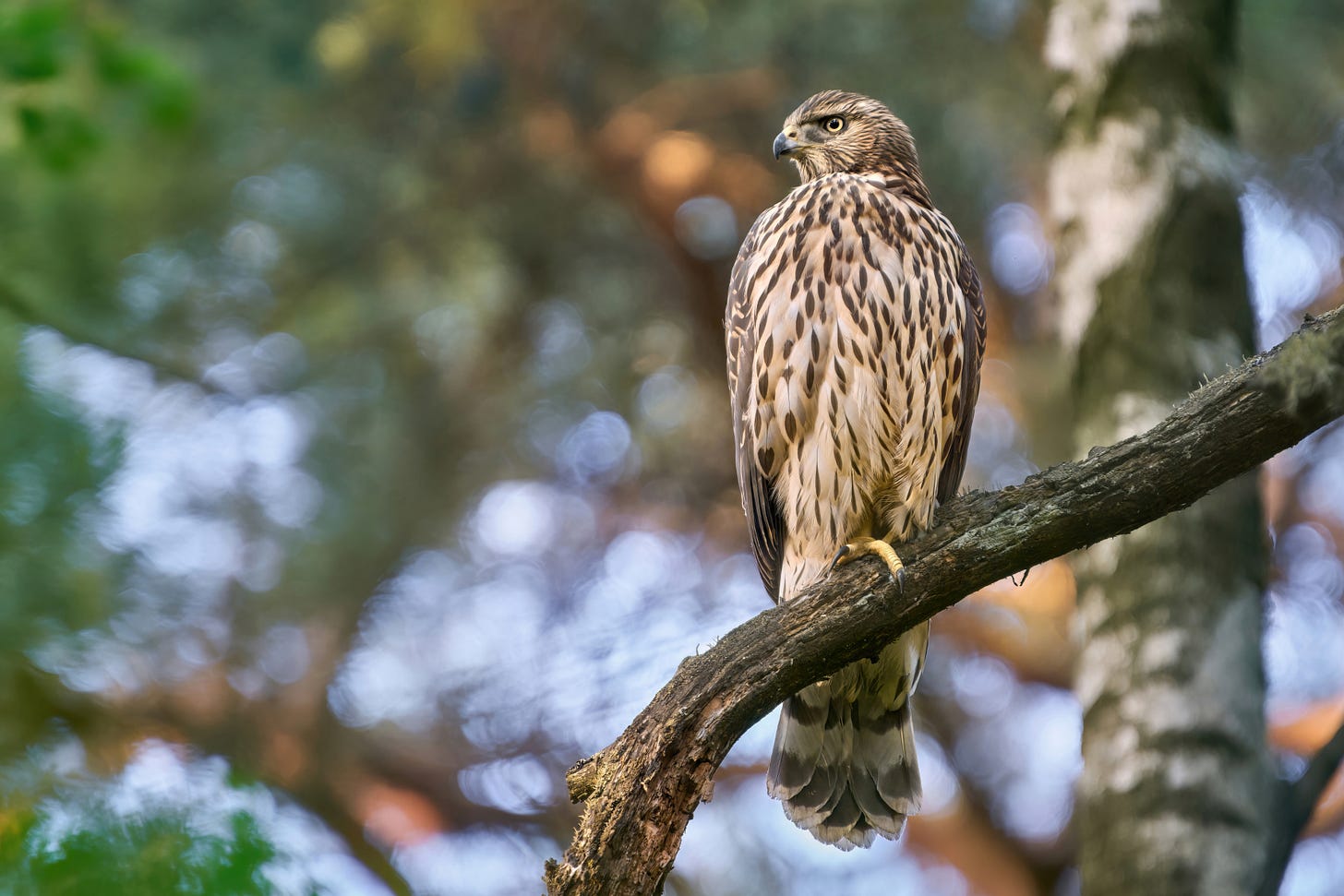
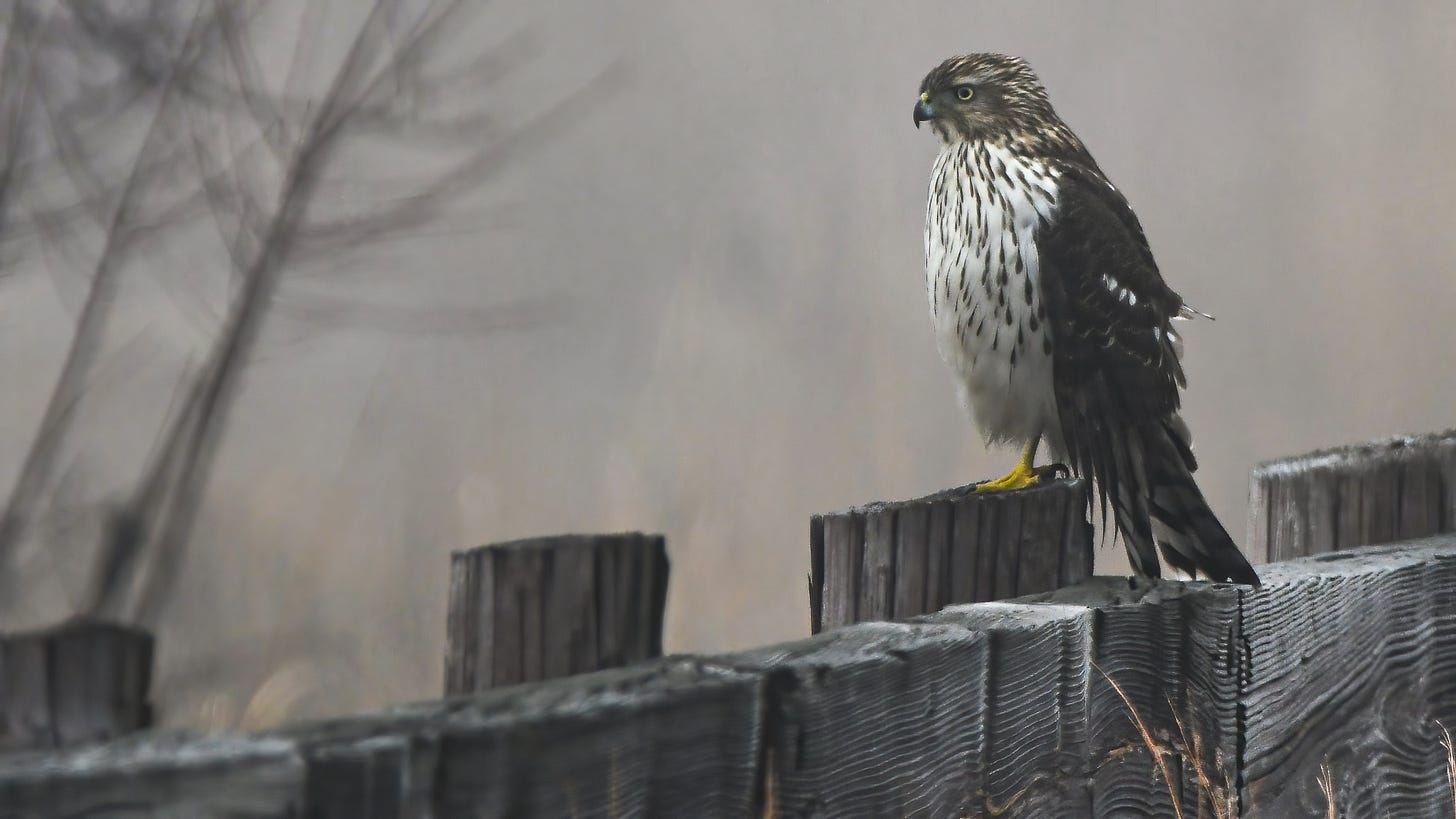
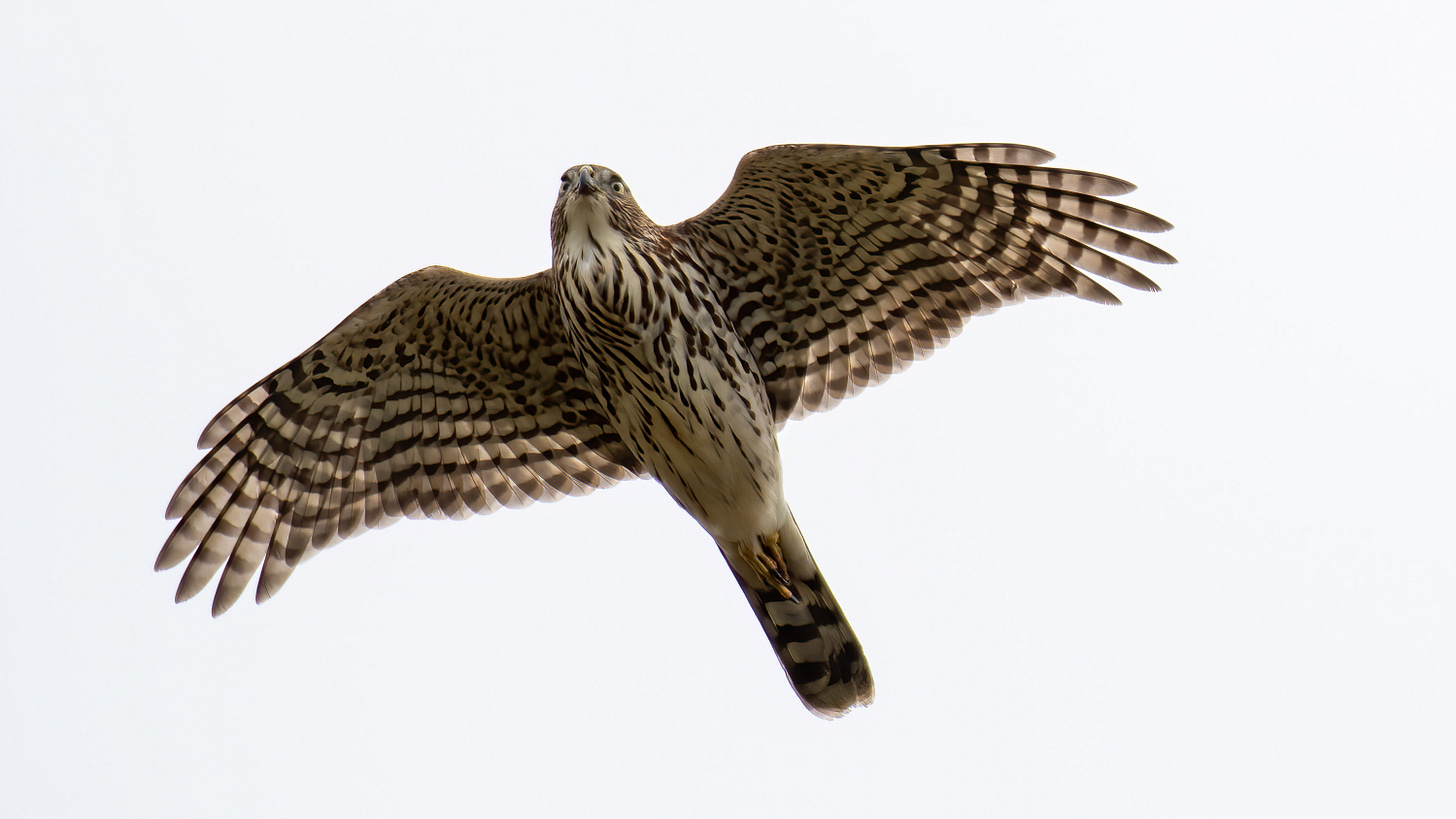
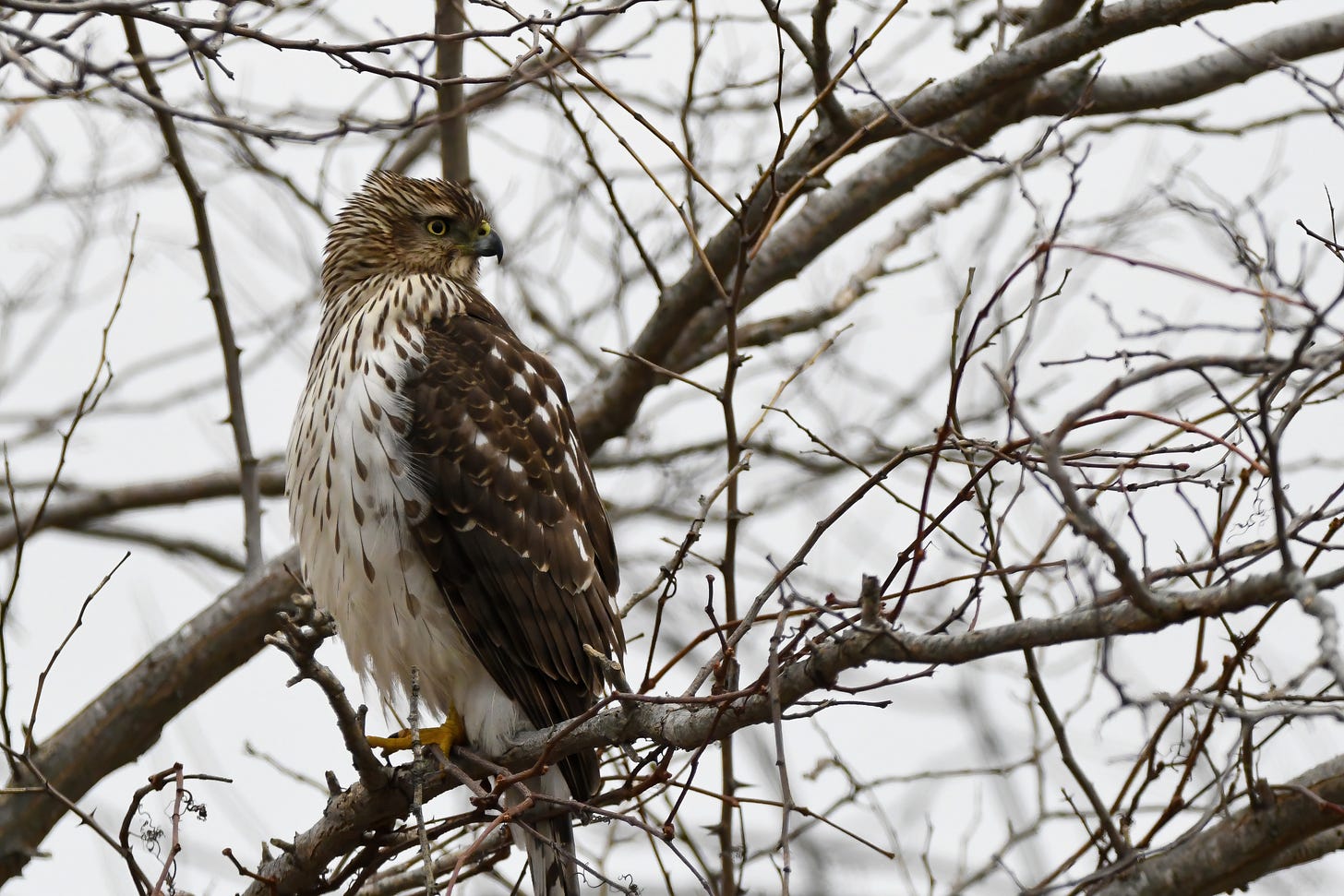
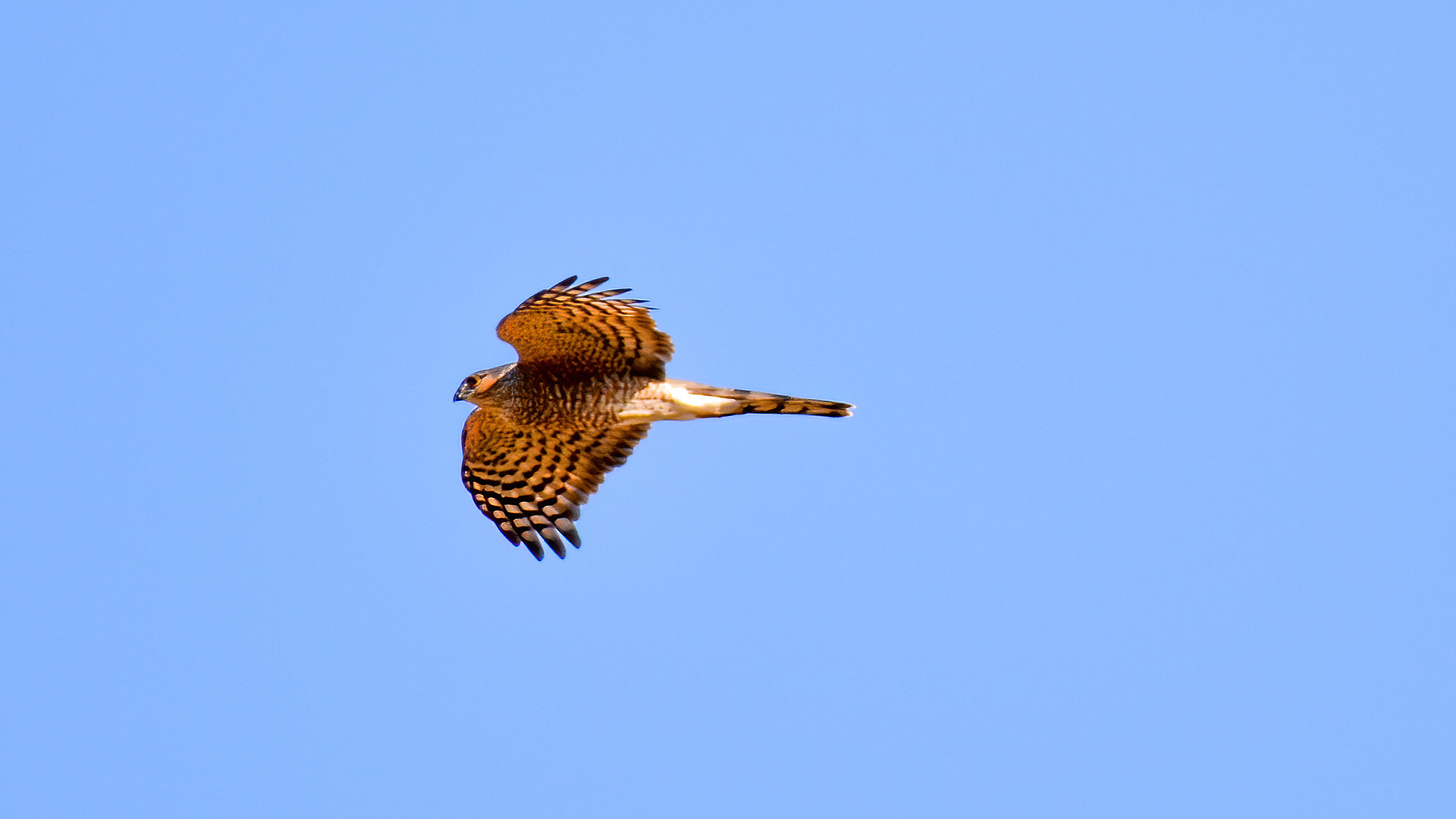
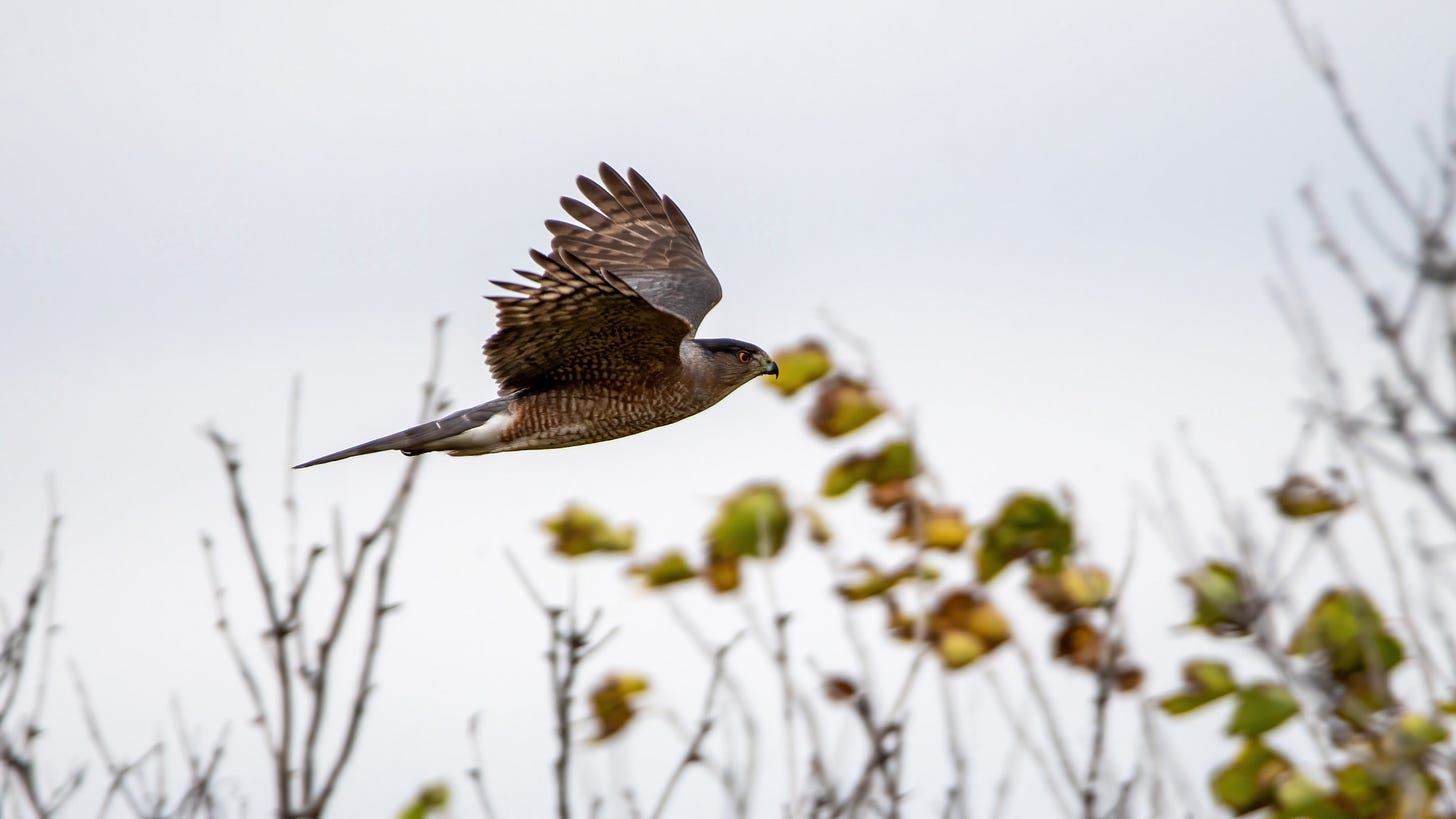

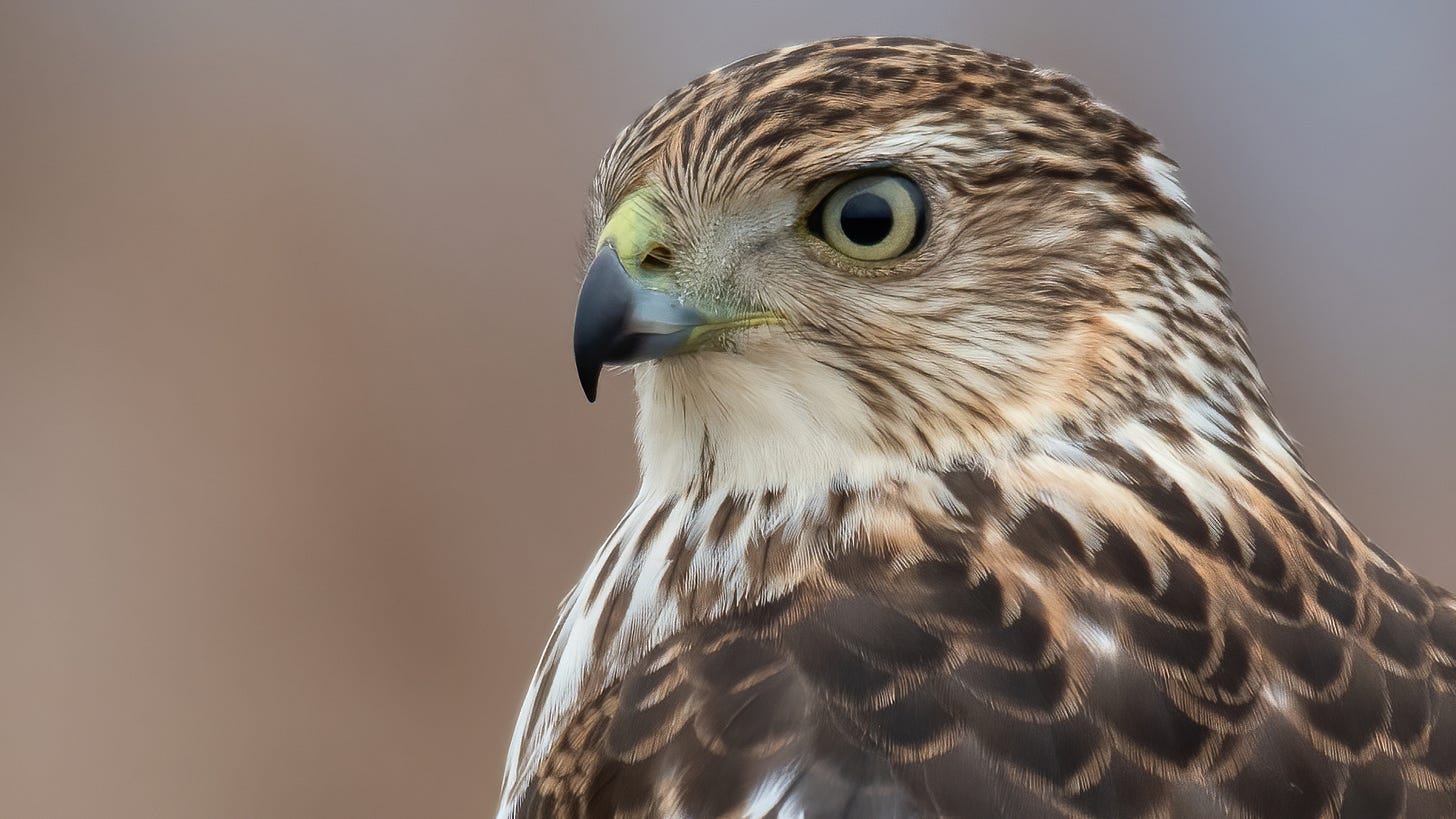

This is such an excellent breakdown, James. I have confused Sharp-shinned Hawks and Cooper's Hawks often in the past. Lately, I've been fortunate to encounter a local family of Cooper's Hawks many times.
These experiences have helped me learn much about their size, shape, markings, and manners. Now to finally sight a Northern Goshawk which I have yet to see! Thanks for the mention as well - very much appreciated.
Excellent article James.